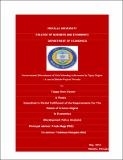| dc.contributor.author | Tsegay, Alem Siyoum | |
| dc.date.accessioned | 2014-09-24T16:43:36Z | |
| dc.date.available | 2014-09-24T16:43:36Z | |
| dc.date.issued | 2014-05 | |
| dc.identifier.citation | Tsegay Alem Siyoum (2014) Socioeconomic Determinants of Girls Schooling Achievement in Tigray Region: A case in Hintalo-Wejerat Wereda, Thesis. Mekelle:MU. | en_GB |
| dc.identifier.uri | https://opendocs.ids.ac.uk/opendocs/handle/20.500.12413/4506 | |
| dc.description.abstract | This study \examines the determinants of girl’s secondary school performance using school
based assessment techniques as a curriculum success. The thesis focuses on the basics of the
socioeconomic background of parents and girls and its role on their overall academic
achievement. It is based on cross sectional data collected from two secondary schools directly
from girl students and their household heads. The data gained via questionnaire has been
analyzed through multiple linear regression models with OLS estimation technique. The thesis
tried to address both issues and challenges of girl’s secondary school performance and its
indispensable determinants using the effect of parental and girls’ background variables
keeping the school contexts controlled. The academic performance and achievement of girls at
school is not the only outcome of their learning, rather many direct and indirect forces react to
each other to determine its success. Among the direct forces which driven performance at
school; the role and expectation of parents is the main and divergent factor in shaping and
supporting students both at school and home. Therefore, the socioeconomic statuses of parents
principally determine the degree of influencing their girl students learning at secondary school.
That is why the thesis was objectively addressed the socioeconomic effects of parents on girls
schooling performance. It informs us that parental education level especially of biological
mother’s year of schooling; girls English language skill and were statistically significant at 5%
and distance to school, age of household head, parental income, tutorial class and birth order
were seen as strongly statistical significance at 1%.Home facilities like electricity was
statistically significant at 10%. Whereas student’s demographic age of both school start and
current age is insignificant to determine level of achievement. Therefore, the thesis strongly
concludes that socioeconomic determinants of girls were centrally relied on parental SES and
in turn is a significant factor for girl’s achievement at secondary school level. | en_GB |
| dc.language.iso | en | en_GB |
| dc.publisher | Mekelle University | en_GB |
| dc.rights.uri | http://creativecommons.org/licenses/by-nc-nd/3.0/ | en_GB |
| dc.subject | Gender | en_GB |
| dc.title | Socioeconomic Determinants of Girls Schooling Achievement in Tigray Region: A case in Hintalo-Wejerat Wereda | en_GB |
| dc.type | Thesis | en_GB |
| dc.rights.holder | Mekelle University | en_GB |


